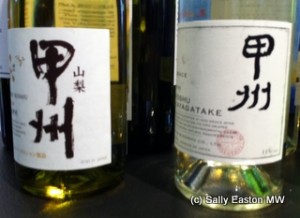'The zen purity of koshu'

Jancis Robinson MW, about to begin
Jancis Robinson MW delivered a masterclass in koshu wines in January 2011.
Koshu is the name of a wine and a grape variety indigenous to Japan, and it is thought vines have been cultivated there for over 1,300 years.
Virtually all – 95% – of koshu is made in Yamanashi prefecture, which lies about an hour and a half west of Tokyo. The dramatic Mount Fuji overlooks the region from its post at the south end of the prefecture.
Robinson said that it has been established that the grape is 98% vinifera. It may have found its way to Japan along the silk route, and records show that it was in the Yamanashi prefecture in 1592. Records also show it was historically a table grape, with its large grapes that retain their structure well.
The variety has thick, pink-grey skins, which need careful and gentle vinification to avoid both colour seepage and phenolic extraction into the wine, which is why a characteristic element of koshu wines is their exceptionally pale and water-white hue, which, on the basis of the tutored tasting, also has a luminous draw to the tint. Plus their supreme cleanliness.
Having visited three times since the late 1990s, Robinson said she was “struck by koshu; I could see that it had a strong character, and it was unlike anything else I’d tasted.”
She reported that Bordeaux professor and producer Denis Dubourdieu identified “the pulp of koshu has similar flavour precursors as sauvignon blanc.” And the overall impression, Robinson said is that “no koshu I’ve tasted has any faults, other than maybe its neutrality. They are all made very well, and very clean.” It seems to be a grape that makes a virtue of its cleanliness and neutrality – “the zen purity of koshu” said Robinson.
Despite koshu being “one of the most neutral grapes I’ve come across, they vary in character, style and quality” said Robinson. “I see a slight parallel with muscadet, with its slight saltiness, low sugar and alcohol.”

The Japanese for 'koshu'
“The centre of operations” she said, “is Yamanashi prefecture, which is 80% mountains, dominated by Mount Fuji. All the vineyards are in a basin [of 400 to 600m elevation] with Mount Fuji (3,776m) in the background.” The climatic downside is the hot and humid summers, which partly account for the traditional pergola training system, to protect from damage and rain. “It’s only quite recently that various experimenters grow with VSP (vertical shoot position), especially Grace” said Robinson. Additionally, she said, Grace Winery has developed a new area at Akeno, at an altitude of 800m above sea level.
Of the 80-odd wineries in Yamanashi, “the typical vineyard is small and parcelled, with lots of small farmers” Robinson said, apart from the two big boys of Suntory and Mercian.
Vintages do vary. The 2009 was unusually round and ripe, while the 2010 was more typical, though “plagued by rain”, with acid levels relatively high.
These wines go very well with sushi and sashimi, the sorts of Japanese foods where the ingredients need to be first class.
Tasting
The defining characteristics of the wines were their purity, clarity and cleanliness. They are typically dry, delicate of body, modest of alcohol, usually around 11% abv, with crisp but not racy acidity. Flavours included white flowers including lily of the valley and elderflower, plus watermelon, crunchy green-skinned apple, citrus, pear, possibly lychee. They are generally made to be best drunk young.
My top half dozen koshus came from the following wineries
Grace Wine
Haramo Wine
Marquis Winery
Rubaiyat
Soryu
Yamanashi



